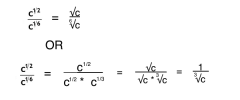![]()
![]()
![]()
Use LEFT and RIGHT arrow keys to navigate between flashcards;
Use UP and DOWN arrow keys to flip the card;
H to show hint;
A reads text to speech;
10 Cards in this Set
- Front
- Back
|
Explain why 5^1/2 is the same thing as √5.
NOTE: ^ symbol denotes exponent |
Finding the square root of a number is the opposite of raising a number to the second power (or "squaring" a number). This means that if the square root of a number is raised to the second power, it will be equal to the number. The two operations cancel each other out. By the rules of exponents, when a number is raised to a power, then raised to a power again, the exponents are multiplied together. 5^1/2 is the same as √5 because when 5^1/2 is raised to the second power (or squared) the result is 5 (the original number), meaning that it is the opposite of 5².
NOTE: ^ symbol denotes exponent |
|
|
Using the rules of exponents, show that 5^1/3 is equal to the ³√5.
NOTE: ^ symbol denotes exponent |
(5^1/3) = ³√5
(5^1/3)³ = (³√5)³ 5¹ = 5¹ NOTE: ^ symbol denotes exponent |
|

Rewrite in root form.
|
³√8
|
|

Rewrite in root form.
|
(³√64)²
|
|

Rewrite in root form.
|
√(9/25)
|
|

Rewrite in exponential form.
|
8x^7/3
NOTE: ^ symbol denotes exponent |
|
|
Rewrite in exponential form. ⁶√51
|
51^1/6
NOTE: ^ symbol denotes exponent |
|
|
Rewrite in exponential form. ⁹√700
|
700^1/9
NOTE: ^ symbol denotes exponent |
|

Simplify. Write your answer in root form.
|

|
|

Simplify. Write your answer in exponential form.
|

|

